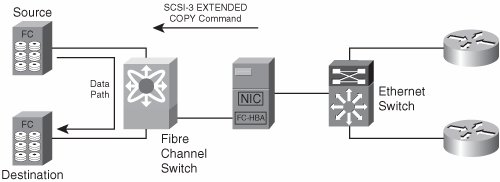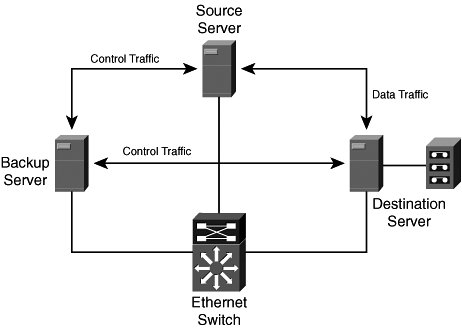Backup Protocols: NDMP and EXTENDED COPY
| Of the many data backup mechanisms, two are of particular interest: the Network Data Management Protocol (NDMP) and the SCSI-3 EXTENDED COPY command. These are of interest because each is designed specifically for data backup in network environments, and both are standardized. NDMPNDMP is a standard protocol for network-based backup of file servers. There is some confusion about this, as some people believe NDMP is intended strictly for NAS devices. This is true only to the extent that NAS devices are, in fact, highly specialized file servers. But there is nothing about NDMP that limits its use to NAS devices. Network Appliance is the leading vendor in the NAS market. Because Network Appliance was one of two companies responsible for the creation of NDMP, its proprietary NAS filer operating system has supported NDMP since before it became a standard. This has fueled the misconception that NDMP is designed specifically for NAS devices. The purpose of NDMP is to provide a common interface for backup applications. This allows backup software vendors to concentrate on their core competencies instead of wasting development resources on the never-ending task of agent software maintenance. File server and NAS filer operating systems that implement NDMP can be backed up using third-party software. The third-party backup software vendor does need to explicitly support the operating systems with custom agent software. This makes NDMP an important aspect of heterogeneous data backup. NDMP separates control traffic from data traffic, which allows centralized control. A central console initiates and controls backup and restore operations by signaling to servers and filers. The source host then dumps data to a locally attached tape drive or to another NDMP-enabled host with an attached tape drive. Control traffic flows between the console and the source/destination hosts. Data traffic flows within a host from disk drive to tape drive or between the source host and destination host to which the tape drive is attached. For large-scale environments, centralized backup and restore operations are easier and more cost-effective to plan, implement, and operate than distributed backup solutions. Figure 1-7 shows the NDMP control and data traffic flows. Figure 1-7. NDMP Communication Model SCSI-3 Extended CopyEXTENDED COPY was originally developed by the SNIA as Third Party Copy (TPC or 3PC) and later standardized by the ANSI T10 subcommittee in revision 2 of the SCSI-3 primary commands (SPC-2) specification. EXTENDED COPY is meant to further the LAN-free backup model by removing servers from the data path. As with traditional LAN-free backup solutions, control traffic between the media server and the host to be backed up traverses the LAN, and data traffic between the media server and storage devices traverses the SAN. The difference is that EXTENDED COPY allows a SAN switch or other SAN attached device to manage the movement of data from source storage device to destination storage device, which removes the media server from the data path. A device that implements EXTENDED COPY is called a data mover. The most efficient placement of data mover functionality is in a SAN switch or storage array controller. Figure 1-8 shows a typical data flow in a SCSI-3 EXTENDED COPY enabled FC-SAN. Figure 1-8. SCSI-3 EXTENDED COPY Data Flow |
EAN: 2147483647
Pages: 196
